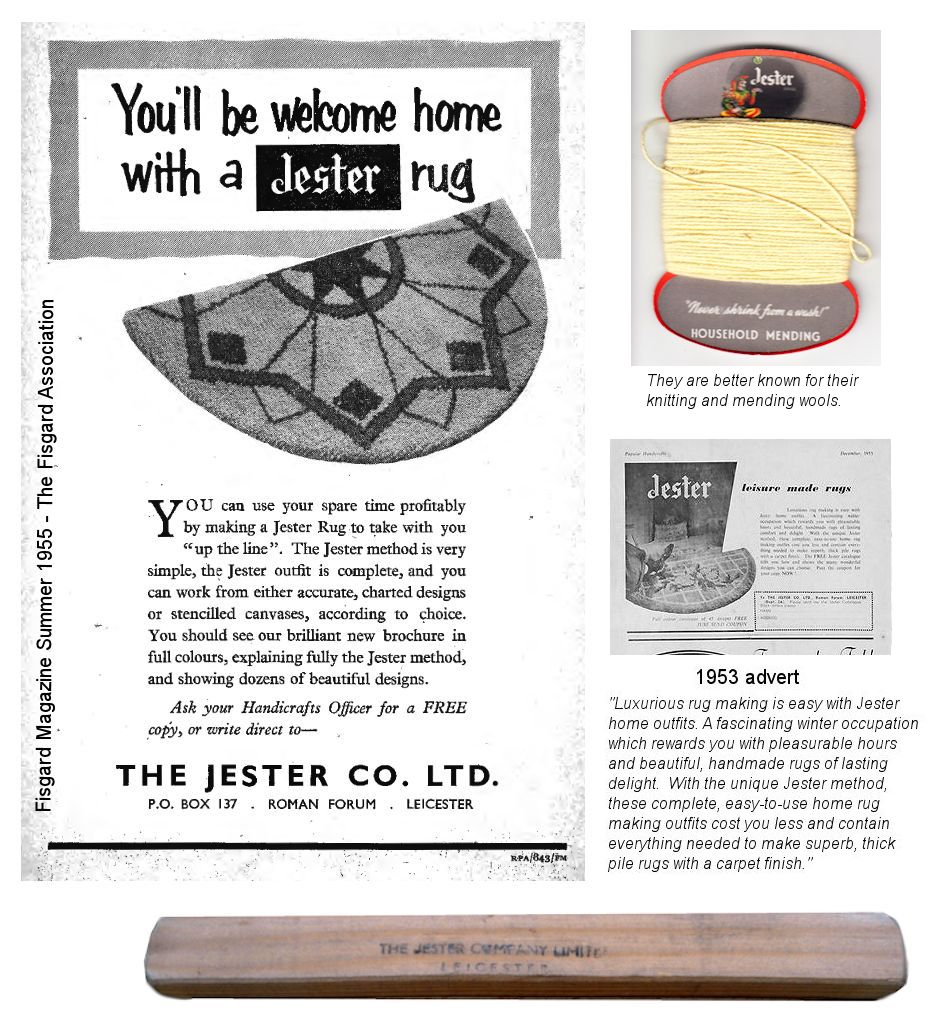
RUG-MAKING SUPPLIES - THE JESTER COMPANY LIMITED
Jester Company limited, Leicester, was a textiles company (knitting wools, patterns, rug kits etc) founded in October 1944, they went into liquidation in 1996 and were finally dissolved in 1997. Their address was Jester House, Roman Forum, Leicester (in 1987 the registered office was at 14 West Walk, Leicester, LE1 7NA and in 1988 it was 91 All Saints Road, Leicester, LE3 5AB) The small 1953 advert for Jester "leisure made rugs"reads: "Luxurious rug making is easy with Jester home outfits. A fascinating winter occupation which rewards you with pleasurable hours and beautiful, handmade rugs of lasting delight. With the unique Jester method, these complete, easy-to-use home rug making outfits cost you less and contain everything needed to make superb, thick pile rugs with a carpet finish." The reader was vited to send for the free Jester catalogue of 42 designs was on offer from the company at Roman Forum, Leicester. I don't know what was uique about the Jester method compared to other kits available at the time.

Luxurious rug making is easy with Jester home outfits. A fascinating winter occupation which rewards you with pleasurable hours and beautiful, handmade rugs of lasting delight. With the unique Jester method, these complete, easy-to-use home rug making outfits cost you less and contain everything needed to make superb, thick pile rugs with a carpet finish. The FREE Jester catalogue tells you how and shows the many wonderful designs you can choose. Post the coupon for your copy NOW !
Their trading address, Jester House, Roman Forum (12 Talbot Lane according to a survey from 1958), dates to the early 19th Century and adjoins No 10 (18th Century) and No 14. It's difficult to find out much about that address as it isn't a factory or shop, but a large, unremarkable house that was once used as a construction HQ when the railway was driven through that part of town (1899). Perhaps it housed the offices and mailing address for the company. It is now a listed building described as a 3-storey stucco (wall-plastered) building with ornate corbels under the cornice and a wide pilaster (fake supporting column) at each end of the frontage. It has a semi-circular fanlight over the central door. The gutter downpipe bears the date 1767 (perhaps it originally belonged to No 10 before No 12 was built). It is terraced to 10 to its left and No 14 to the right. So why did they use "Roman Forum" as their address in the 1950s? This part of Leicester, now the Parish of St Nicholas, was once the Roman Forum. In the era of 1960s concrete brutalism, the forum area was demolished to make way for a road.
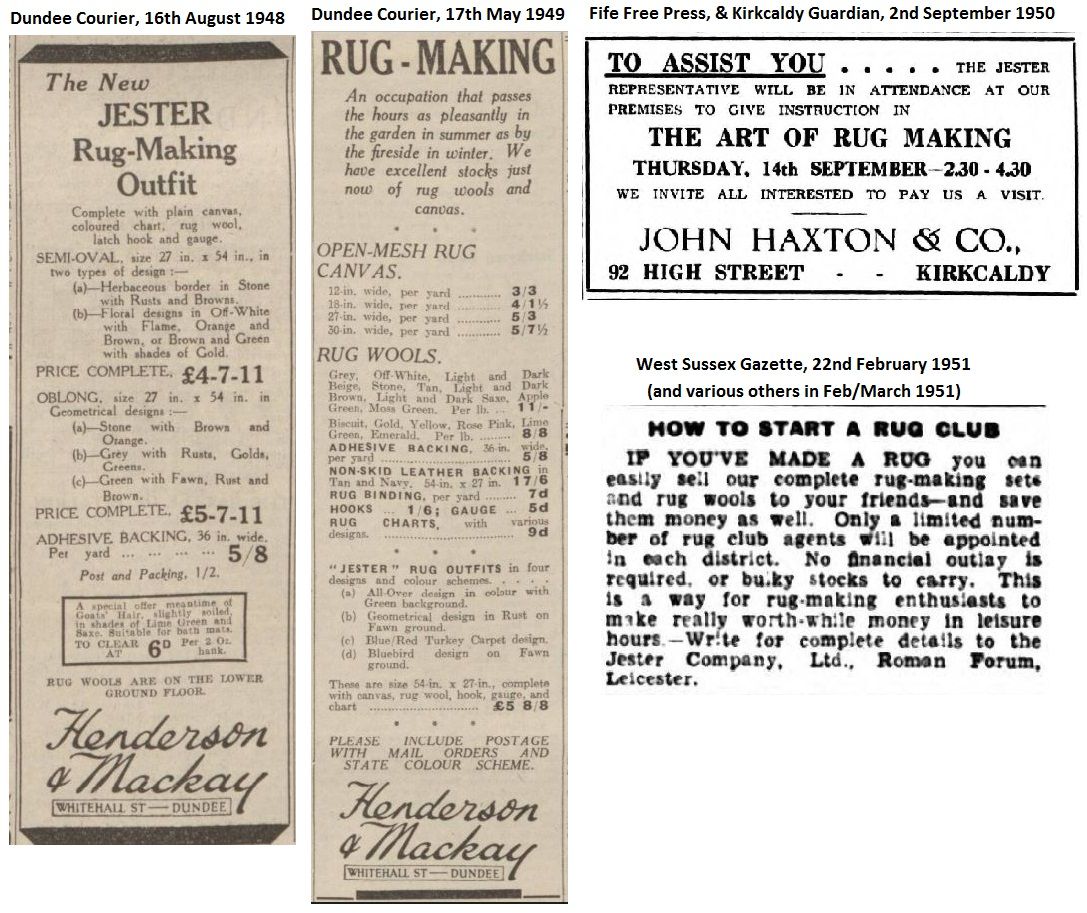
Jester produced its small-format rug booklet on high quality thick paper rather than magazine paper. Inside, the first two pages were illustrated in the style of a children's book and accompanied by information about the origin of rug patterns and about home rug-making. The canvas depicted in its instructions was 8-hole style with wide tramlines instead of twisted warp threads. Red threads divided this canvas into 8 x 8 - 64 hole squares. Jester patterns were a mix of Persian-inspired designs, Chinese-inspired designs and English floral designs. There was also their version of the popular "galleon" design. Many designs were available as rectangular rugs (some available in different sizes) and semi-circular rugs.
Jester promoted the "Jester method" of rugmaking. It used the "Jester tuft" (known to others as the Method 2 knot). The pre-cut wool was packed in square packs. These packs stated that they contained sufficient wool to cover 3 red-lined squares (i.e. 192 strands). Other companies selling pre-cut wool had standardised on packs of 160 and/or 320 strands. Instead of working one row at a time, the Jester method suggested working one red-lined square at a time from left to right. To make this easier, the customer was instructed to paste the chart onto cardboard and to use the Jester chart-reader. The pattern-reader was a length of clear plastic, with clips at each end, and a movable red-bordered grid-marked square on it. This was looped around the board so that the grid-marked square (representing an 8 x 8 hole red-lined canvas square) could be slid along it. The whole band was then moved to the next row of squares. Oddly, this is close to the method I use - complete a square(ish) section at a time across the rug. I find it easier than working a single row at a time. Rather than latch-hooking through a double layer of canvas at each end, Jester advised the rug-maker to turn those ends underneath after working the rug.
The catalogue expressed Jester's hope of expanding its rug kit operation into international markets. I can't find any evidence of this happening, perhaps because Readicut already dominated the overseas market. I don't know how widespread Jester Rugs were, how long Jester produced them or how many Jester stockists existed.
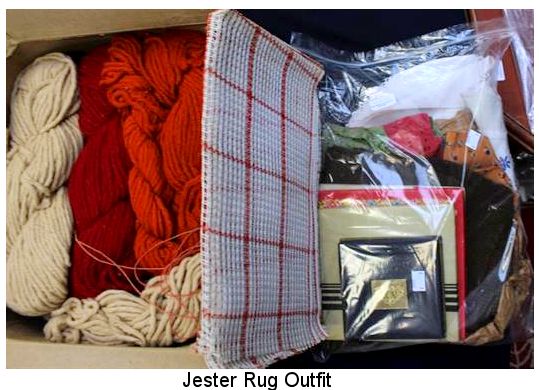

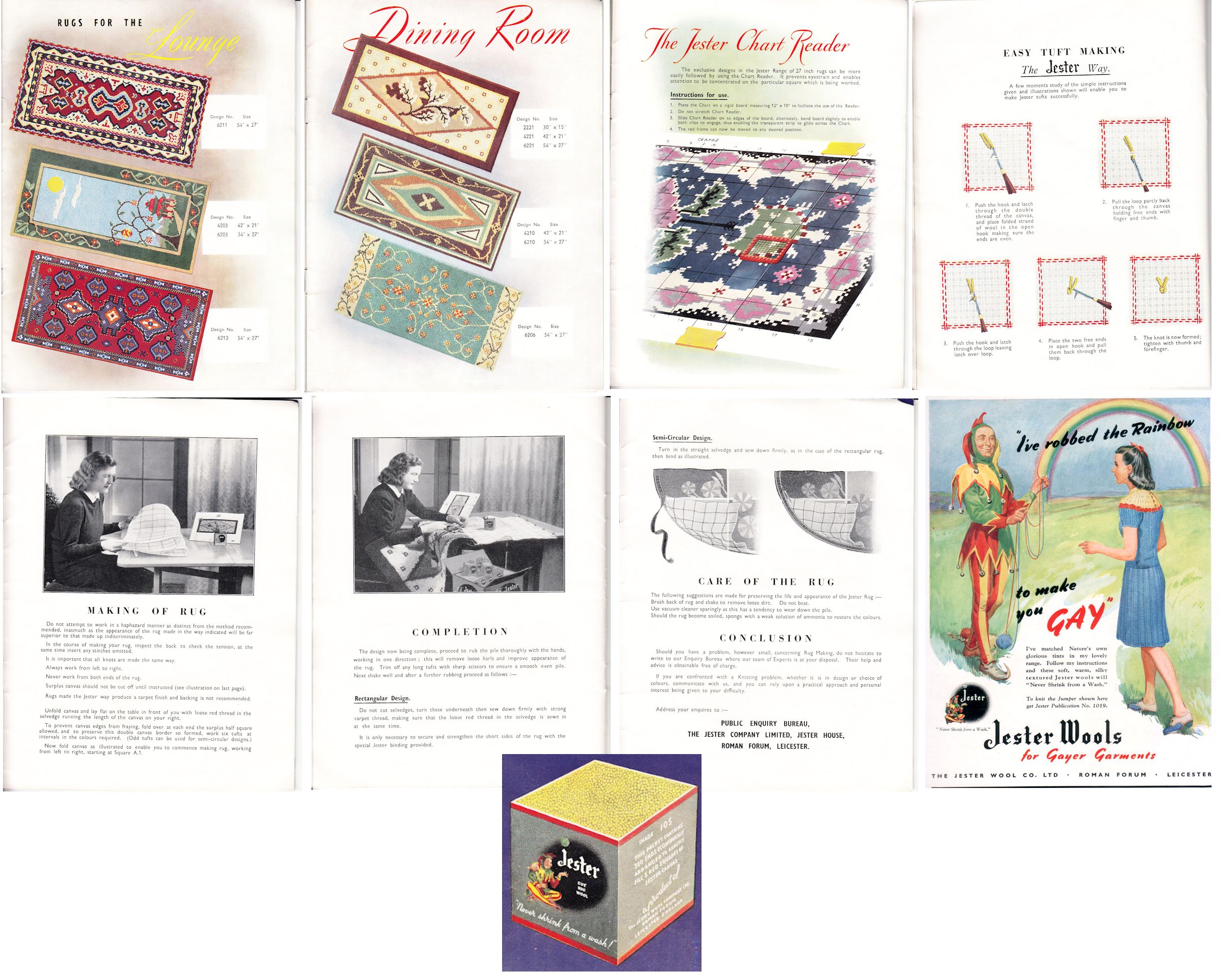
The Jester Company appears to be better known from its incarnation as "Jester Wool Company." Its 1950s knitting patterns are now collectible because of their artwork. Jester knitting yarns were advertised as early as 1947, predating their rug wool operation ( 1955). Unlike most other knitting patterns of that era, the garments were drawn rather than photographed. The childrenís patterns were produced as booklets with a paragraph about the child depicted in the pattern. The drawings depicted childhood in an innocent bygone age reminiscent of the original Ladybird "Peter & Jane" book illustrations. The illustrations on the adult knitting patterns were beautifully and stylishly drawn. In adverts, the Jester was accompanied by the motto "Iíve robbed the rainbow to make you Gay. Jester Wools for Gayer Garments" - at that time "gay" meant bright colours and light-heartedness.
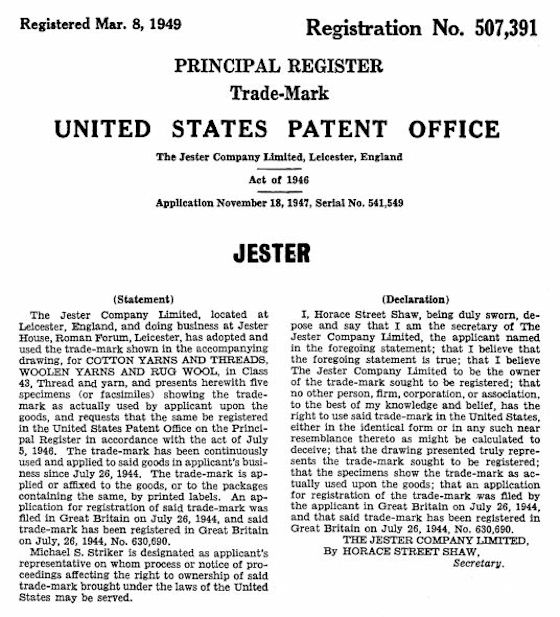
|

|
A Jester rug design. The rug uses 10-hole canvas with a red guide thread at a time when the 8-hole Turkey canvas was fairly standard. The reference to special canvas very likely means twisted warp threads instead of tramlines for both warp and weft.
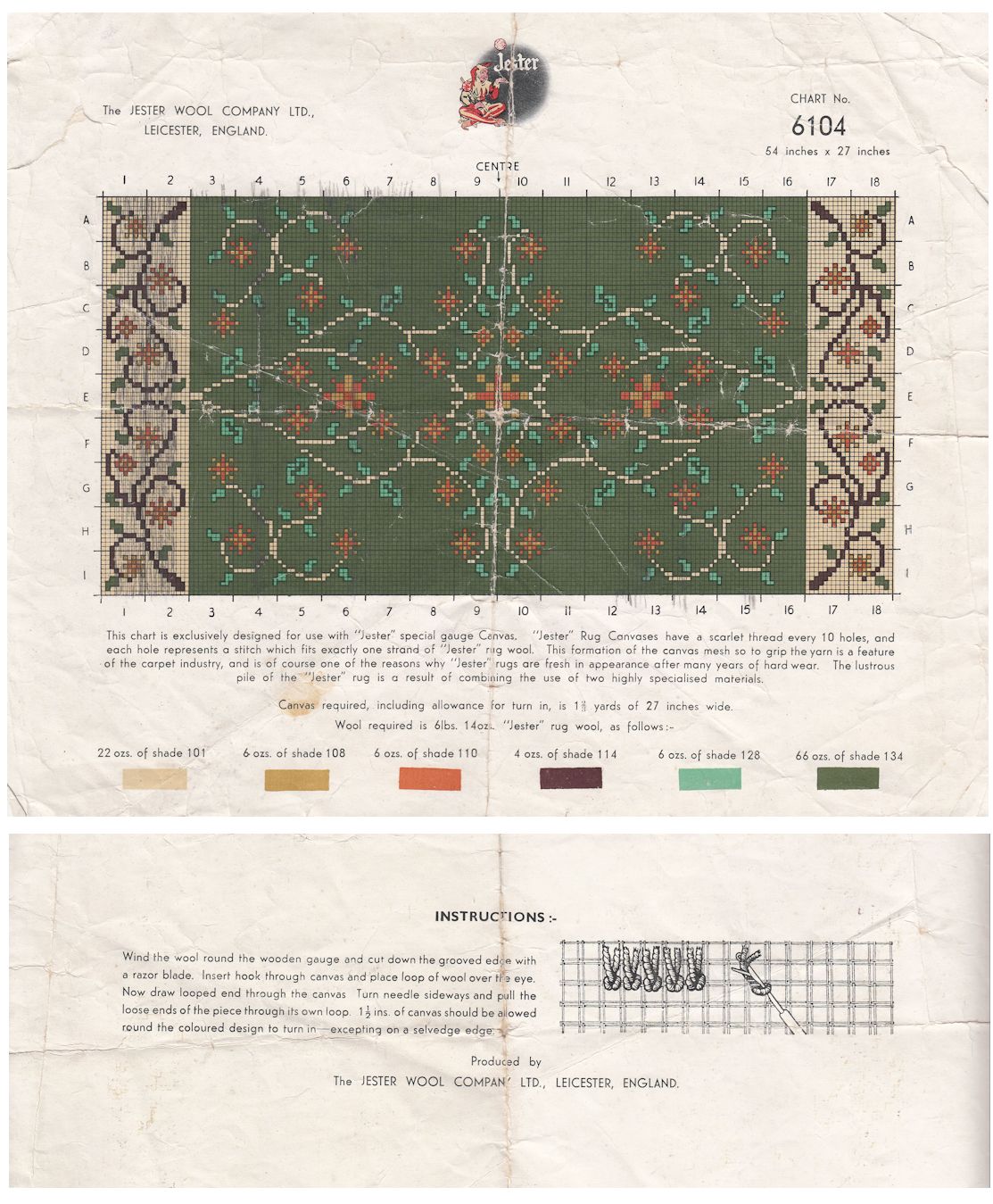
One of the few traces this company has online is a Patent for packages of bobbins. Patent no US 3,841,475 A1, filed: 31 August 1972 and issued 15 October 1974. This was "A package for bobbins of the type used with domestic sewing machines, comprising a backing means and a cover secured to said backing means to form a package, at least two under bobbins for domestic sewing machines disposed within said package, each of said bobbins being wound with the same type and shade of thread, each of said under bobbins being of a different type such that both bobbins are adapted to fit the majority of domestic sewing machines." The inventors was Shirley Russell Ellis. Basically this was a cardboard-backed blister pack containing generic bobbins in 2 slightly different heights, pre-wound with thread. These bobbins fitted most household sewing machines and were reusable. While The Jester Company Ltd hasn't survived, their patent was cited in several others pertaining to this type of packaging.
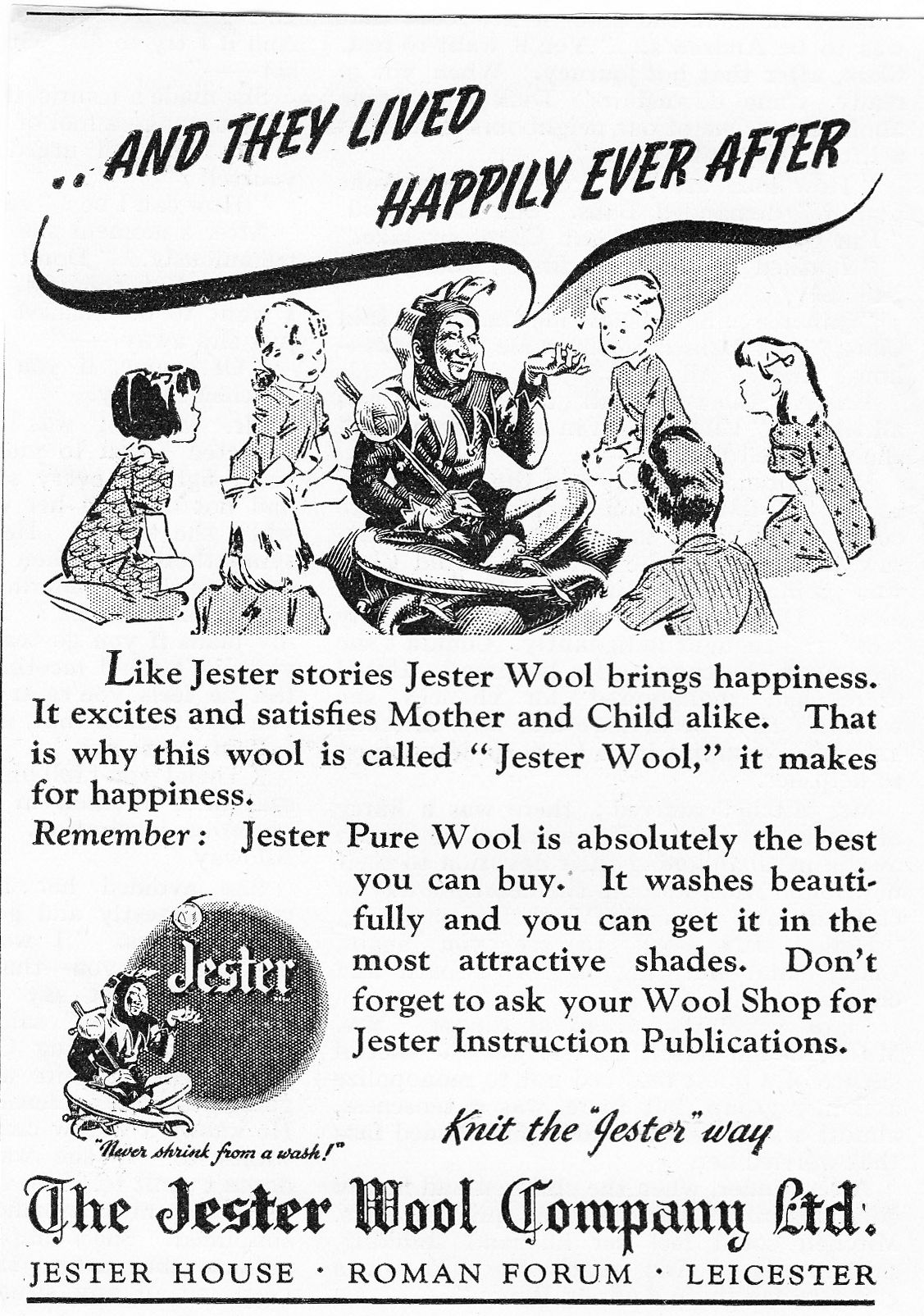
|
See Flickr where images and patterns can be downloaded at full resolution for your own use.
You are visitor number: